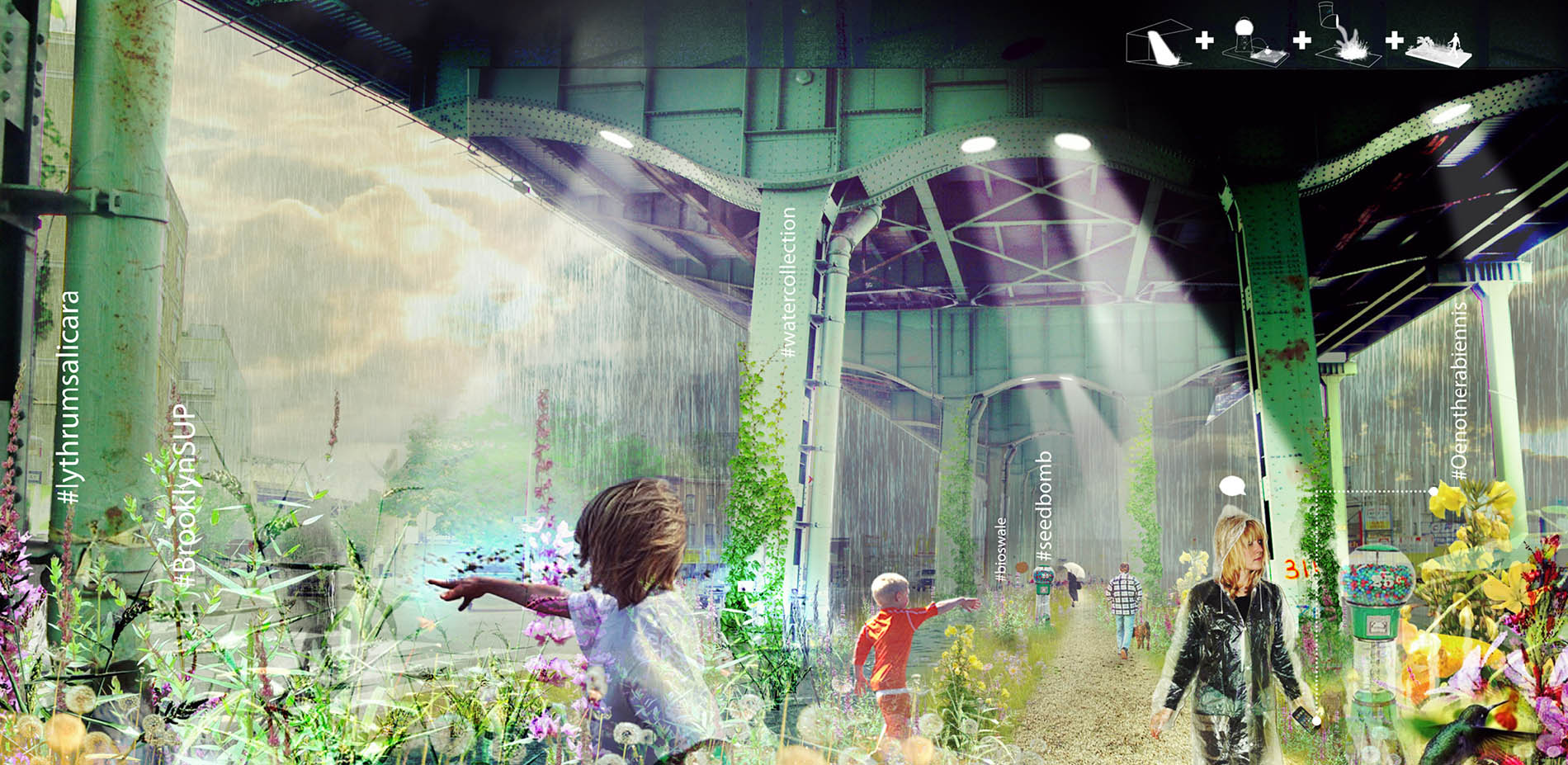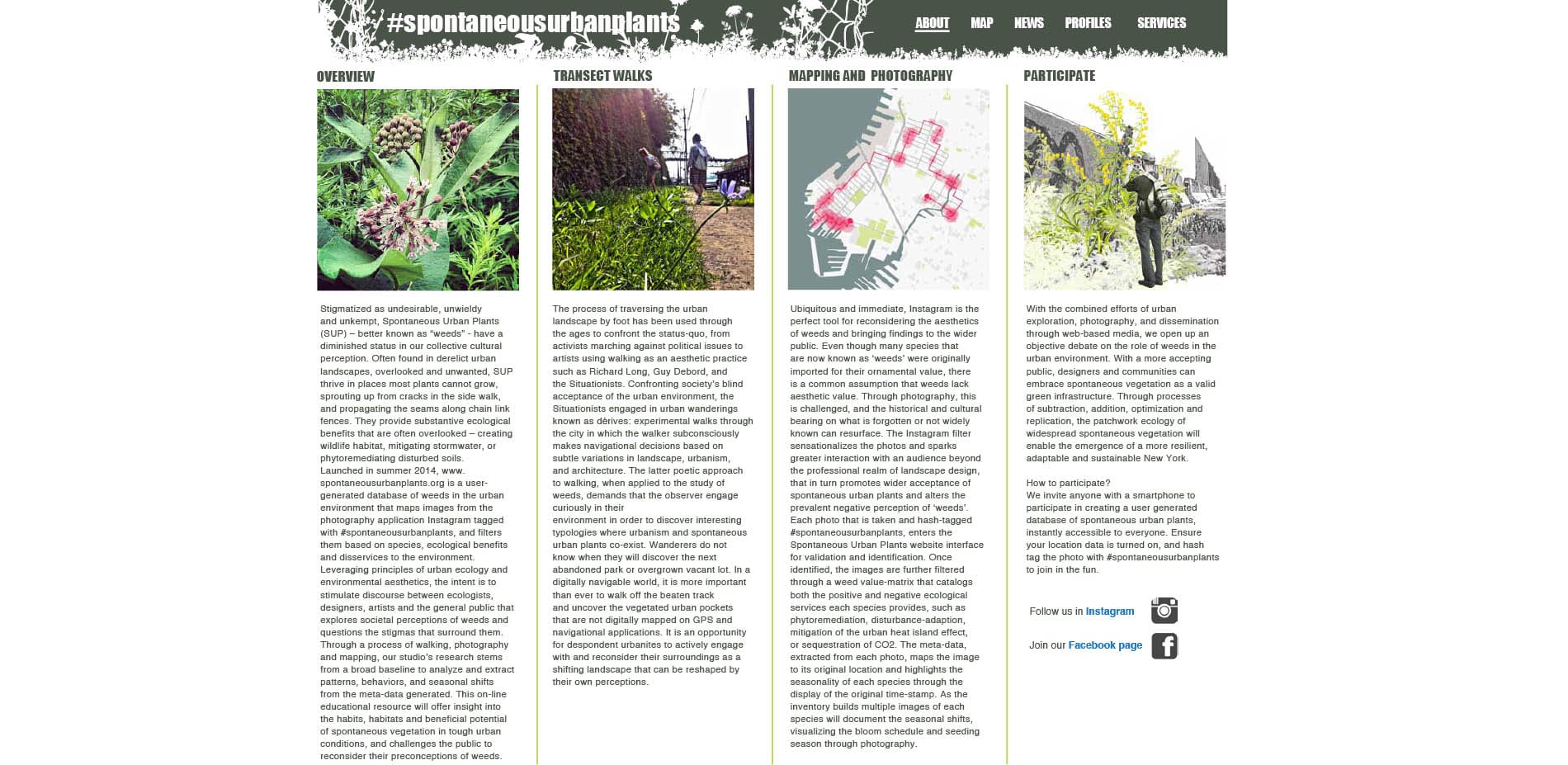
Photo Credit: Future Green Studio
Media: Please submit high-resolution image requests to images@asla.org.

Research Approach
Photo Credit: Future Green Studio
Media: Please submit high-resolution image requests to images@asla.org.
PHOTO INDEX – A user generated database of urban plants photos which uses social media platforms and mobile phone technology to generate mappings of the plant locations and filter the images for visual optimization.
Photo Credit: Future Green Studio
Media: Please submit high-resolution image requests to images@asla.org.
TRANSECT WALKS – Photographic walking tours were conducted throughout the edges and urban fringes of New York City to document the predominant local weed species. In the spirit of the Situationists and Guy Debord’s “Theory of the Derive”, the tours were not planned out or prescribed in advance but rather unfolded organically in response to the intentions of the walkers.
Photo Credit: Future Green Studio
Media: Please submit high-resolution image requests to images@asla.org.
SOCIAL MEDIA AS A RESEARCH PLATFORM – This project uses the application Instagram to generate and disseminate information about spontaneous urban plants (SUP). A user snaps a photo of a plant, hashtags it #spontaneousurbanplants and posts it to their network of friends. Friends can like, comment or report the photos – distributing the images to a larger social network while promoting awareness of the resilient, ecologically productive system of weeds. Instagram filters help to optimize the photos and sensationalize the content, elevating the status of the weeds from an overlooked ecology to something more desirable.
Photo Credit: Future Green Studio
Media: Please submit high-resolution image requests to images@asla.org.
WEED VALUE MATRIX – Plant data was generated from an analysis of the transect walk photos. This diagram denotes the number of each predominant SUP species found and the associated ecological services they provide.
Photo Credit: Future Green Studio
Media: Please submit high-resolution image requests to images@asla.org.
WEED HABITATS – Through our transect walks, research and investigations we identified key urban conditions or habitats where SUP were likely to emerge.
Photo Credit: Future Green Studio
Media: Please submit high-resolution image requests to images@asla.org.
APPLIED HABITATS – The analysis of SUP habitats led to an understanding that the substrate, along with key elements like light and water, is the catalytic force that allows SUP to colonize our cities. Processes of addition, replication, optimization and subtraction can enhance found habitats and promote more aesthetically pleasing and ecologically productive SUP environments.
Photo Credit: Future Green Studio
Media: Please submit high-resolution image requests to images@asla.org.
ILLUSTRATIVE VISION – OPTIMIZED HABITATS - Rendering of the potential urban condition where SUP habitats have not only been allowed to persist but optimized to generate a substantive, resilient urban ecology. It is understood that these types of plants and conditions have an inherent hardiness that is best suited to adapt to the variable and extreme weather conditions of climate change.
Photo Credit: Future Green Studio
Media: Please submit high-resolution image requests to images@asla.org.
WEBSITE: MAPPING PLANTS – In order to formalize the photo index into a searchable, educational resource we’ve developed the website www.spontaneousurbanplants.org. This interactive tool maps user’s photos by location, identifies plant species, profiles plant characteristics, and identifies key local ecological services the plants offer.
Photo Credit: Future Green Studio
Media: Please submit high-resolution image requests to images@asla.org.
WEBSITE: PLANT PROFILES – Descriptive profiles of prominent SUP species offer more detailed information about preferred habitats, flower bloom time and seed dispersal patterns. In addition, the ecological services the species provides – like carbon capture or stormwater retention – are explained and quantified in dynamic charts that are updated with each plant photo added.
Photo Credit: Future Green Studio
Media: Please submit high-resolution image requests to images@asla.org.
WEBSITE: MAPPING ECOLOGICAL SERVICES – While perceived as undesirable and a disservice to humans, many SUP provide substantive ecological benefits. Ecological services include mitigating the urban heat island effect, capturing stormwater runoff, providing wildlife habitat and capturing carbon dioxide. Additionally, many SUP have rich cultural histories and have been historically used for their medicinal and edible characteristics, among others. When such processes provide benefits and value to humans they are defined as ecosystem services (medicinal use, edibility, phytoremediation, carbon capture, erosion control, etc.). Many plant species play an important role in providing such services. In recent decades ecologists have identified plant traits that are crucial for providing such processes and services. The following is an abbreviated list of performative attributes that have been identified for spontaneous urban plants.
Photo Credit: Future Green Studio
Media: Please submit high-resolution image requests to images@asla.org.
WEBSITE: ECOLOGICAL SERVICES DESCRIPTION – In ecology an ecosystem service is defined as the flow of energy and materials through the arrangement of biotic and abiotic components of an ecosystem, including net primary production, trophic transfer from plants to animals, nutrient cycling, water dynamics, and heat transfer.
Photo Credit: Future Green Studio
Media: Please submit high-resolution image requests to images@asla.org.
BOOK: #SPONTANEOUSURBANPLANTS – This book developed with Archer Press and Rarebird Books synthesizes the website research into a series of plant profiles and essays which are intended to catalyze discussions around the topic of SUP.
Photo Credit: Future Green Studio
Media: Please submit high-resolution image requests to images@asla.org.

















